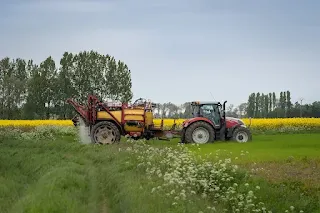The Role of Agriculture in Economic Development and Poverty Reduction
Agriculture has long been a cornerstone of economic development and poverty reduction, particularly in developing countries where a significant portion of the population relies on farming for their livelihoods. As the world faces pressing challenges such as food insecurity, climate change, and economic inequality, understanding the vital role agriculture plays in promoting economic growth and alleviating poverty is more important than ever. This blog post explores the multifaceted contributions of agriculture to economic development and poverty reduction, examining its impact on income generation, employment, food security, and overall societal well-being.
The Economic Importance of Agriculture
Contribution to GDP
Economic Output: Agriculture is a significant contributor to the Gross Domestic Product (GDP) of many developing countries. It provides essential goods and services that drive economic activity and growth.
Value Addition: Beyond primary production, agriculture encompasses various value-added activities, including processing, packaging, and distribution, which further enhance its economic significance.
Job Creation
Employment Opportunities: Agriculture is one of the largest employers globally, especially in rural areas where alternative job opportunities may be limited. It provides direct employment to millions of farmers, laborers, and agribusiness workers.
Rural Development: By supporting agriculture, economies can foster rural development, reducing urban migration and the associated challenges of overcrowded cities.
Income Generation
Poverty Alleviation: Increasing agricultural productivity directly raises incomes for farming households, enabling them to improve their living standards. Higher income levels contribute to poverty reduction and economic stability.
Market Opportunities: Agricultural development opens up markets for smallholder farmers, allowing them to sell their produce at fair prices, which can significantly enhance their economic prospects.
Agriculture and Poverty Reduction
Food Security
Meeting Nutritional Needs: Agriculture is essential for food production, ensuring that populations have access to sufficient, safe, and nutritious food. Food security is a critical component of poverty reduction, as hunger and malnutrition can trap individuals and families in poverty.
Stabilizing Prices: A robust agricultural sector can stabilize food prices, protecting low-income consumers from price volatility and ensuring affordable access to essential food items.
Empowerment of Marginalized Groups
Women in Agriculture: Women play a crucial role in agricultural production, yet they often face barriers to access land, resources, and training. Supporting women in agriculture can lead to enhanced productivity and improved household income, benefiting entire communities.
Youth Engagement: Engaging young people in agriculture can foster innovation and sustainable practices while providing them with income-generating opportunities. This engagement is vital for reducing rural youth unemployment and poverty.
Access to Resources and Services
Financial Services: Agricultural development often leads to increased access to financial services, such as credit and insurance, which are crucial for farmers to invest in their operations and manage risks.
Education and Training: Agricultural initiatives frequently incorporate training programs that educate farmers about modern farming techniques, sustainable practices, and market access, enabling them to improve their productivity and incomes.
The Role of Technology and Innovation
1. Enhancing Productivity
Research and Development: Investments in agricultural research and development lead to innovations in crop varieties, pest management, and farming practices. These innovations can significantly increase agricultural productivity and resilience to climate change.
Precision Agriculture: Advancements in technology, such as precision agriculture, enable farmers to optimize resource use, reduce waste, and increase yields, thereby enhancing profitability and sustainability.
2. Digital Agriculture
Access to Information: Digital technologies, including mobile apps and online platforms, provide farmers with vital information about market prices, weather forecasts, and best practices, empowering them to make informed decisions.
E-commerce Opportunities: Digital platforms facilitate direct sales to consumers, reducing reliance on intermediaries and increasing farmers' profits.
Challenges Facing Agriculture
Climate Change
Impact on Productivity: Climate change poses significant risks to agriculture, including extreme weather events, changing rainfall patterns, and increased pest and disease pressures. These challenges threaten food security and farmers' livelihoods.
Sustainable Practices: Adopting sustainable agricultural practices, such as agroforestry, crop rotation, and organic farming, can help mitigate the impacts of climate change and promote long-term resilience.
Access to Resources
Land Tenure Issues: In many regions, land tenure insecurity limits farmers' ability to invest in their land and improve productivity. Clear land rights and equitable access to land are essential for agricultural development.
Investment in Infrastructure: Inadequate infrastructure, such as roads, irrigation systems, and storage facilities, can hinder agricultural productivity and market access, particularly for smallholder farmers.
Policy Recommendations
Support for Smallholder Farmers
Access to Credit and Inputs: Governments should provide financial support and access to quality seeds, fertilizers, and technology for smallholder farmers, enabling them to increase productivity and income.
Market Access Programs: Initiatives that connect farmers to markets, cooperatives, and value chains can enhance their bargaining power and income potential.
Investment in Agricultural Research and Extension Services
Innovation and Knowledge Transfer: Investing in agricultural research and extension services can facilitate knowledge transfer and the adoption of best practices, ultimately enhancing productivity and sustainability.
Climate-Smart Agriculture: Promoting climate-smart agricultural practices can help farmers adapt to climate change while improving food security and livelihoods.
Infrastructure Development
Improving Rural Infrastructure: Investments in rural roads, irrigation systems, and storage facilities can enhance market access and reduce post-harvest losses, improving farmers' incomes and food security.
Social Safety Nets
Support for Vulnerable Populations: Establishing social safety nets, such as cash transfers or food assistance programs, can help vulnerable populations cope with economic shocks and reduce poverty.
Conclusion
Agriculture plays a vital role in economic development and poverty reduction, serving as a foundation for economic growth, job creation, and food security. By investing in agriculture, supporting smallholder farmers, and promoting sustainable practices, governments and organizations can harness the potential of the agricultural sector to uplift millions from poverty. Addressing the challenges faced by agriculture, including climate change and access to resources, is essential for creating a resilient and equitable future for all. The path to poverty reduction and economic development lies in recognizing and strengthening the critical role that agriculture plays in our societies.
